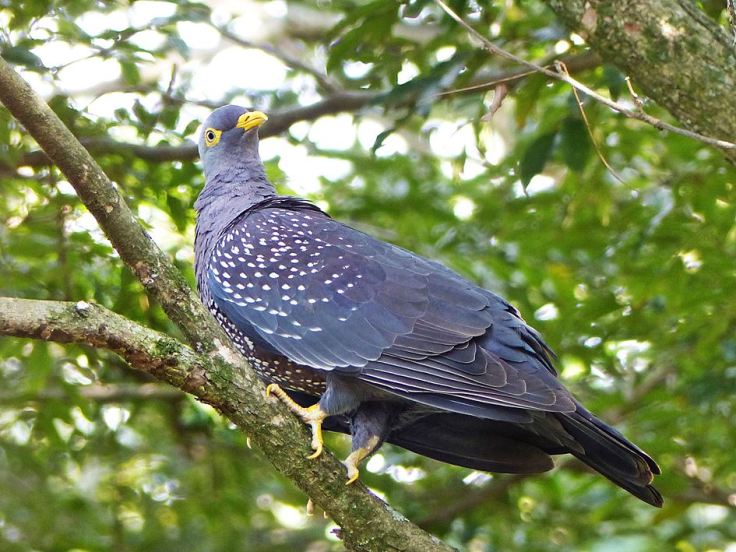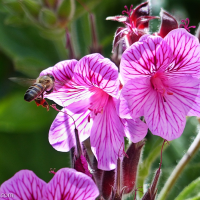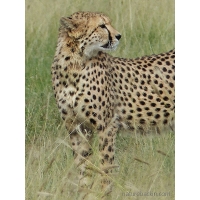What has bright yellow legs and bill, is predominantly purple-brown with beautiful speckled markings and hints of iridescence, a soothing deep and almost resonant call, clambers about in large trees with clumsy agility in search of small fruits, and is one of my favourite garden birds?
It is southern Africa’s largest pigeon known previously known as the Rameron Pigeon but now officially named the African Olive-Pigeon. My favourite name for it is the Afrikaans Geelbekbosduif, which rolls easily off the tongue. It literally means yellow-billed-bush-dove, raising the question: is this a pigeon or a dove? Often the terms are used interchangeably, but usually the term pigeon refers to the larger species of bird in the pigeon-dove family Columbidae.
And the African Olive-Pigeon is large, about 40 cm long, with males weighing about 460 grams and the smaller females about 415 grams.

As these pictures show, the African-Olive Pigeon is powerfully built. It is usually shy and very wary – a wise precaution against predation by some raptors, including the African Goshawk and the Black Sparrowhawk (both of which occur in our suburb), and also being killed by human hunters. It is considered to be a game bird and it is targeted by wingshooters

All doves and pigeons are strong flyers and agile at maneuvering when in flight. Interestingly, their flight muscles make up 44% of their body mass. The Rameron/African Olive-Pigeon (Columba arquatrix) is one of the species in the genus Columba, which comprises medium to large stout-bodied pigeons. The Latin term Columba derives from the Ancient Greek for “diver” (as in swimming), and the name is given to this genus of birds because of its swimming motion when flying.
No exception to this rule, the African Olive-Pigeon is a swift flyer with quick regular wingbeats. I am always amazed to see its rapid almost vertical take-off into the treetops after it has come to the ground to drink.

An African Olive-Pigeon perching, appropriately enough, in a Pigeon Wood (Trema orientalis) in our garden. The small fruits of this tree appear to be a favourite and a number of Olive-Pigeons hangout in our garden during the months when this tree is in fruit
Rameron/African Olive-Pigeons live in the forest canopy in evergreen lowland, riverine and mountain forests, and they can also be found in some plantations and gardens. Nests, made of sticks and twigs and sometimes lined with leaves protected by branches and foliage, are built high up in the fork of a tree, with the male collecting the material and the female building the nest. Pairs mate for life and share incubating their eggs and raising their young. Usually only one egg (rarely two) is laid in a clutch. They may have several broods per season, with summer to autumn being the main breeding season.
In isiZulu, the name of the Rameron/African Olive-Pigeon is iVukuthu-lehlathi. iVukuthu is the general term for dove, and like “turtur” in Latin (for turtle doves, for more see here), it is imitative of the repetitive cooing sounds made by most doves and pigeons. As far as I can ascertain, lehlathi means “of the forest” in isiZulu, and so the name alludes to the bird’s forest habitat. Any readers who speak isiZulu please do comment.
On the subject of calls, the African Olive-Pigeon has a very deep almost resonant call, including a deep quiet purring noise that is typical of many doves/pigeons and is thought to function in mate-bonding. It certainly is a soothing sound to the human ear.
Although their numbers seem to be declining, largely because of hunting and the loss and fragmentation of habitat, currently (because of their large range) they are not yet listed as a vulnerable species. They occur in many countries in eastern, central and southern Africa from Ethiopia southwards. They also occur in parts of the Arabian peninsula.

An African Olive-Pigeon foraging for fruits in a Pigeon Wood tree in our garden
The name Rameron Pigeon is still commonly used in South Africa, although the internationally standardised “new” name, African Olive-Pigeon, is likely to be increasingly adopted even by diehards who have a hard time giving up familiar names. (Henceforth I will try to quell my inner diehard!) Ornithologist and naturalist David Johnson observes (see here) that the “olive” part of the name is probably linked to the species preference for small fruit, as it is not reflective of its colouring.
The birds clamber around in the trees, often leaning forward at awkward angles to retrieve fruits. Even when concealed in the tree canopy, their loud wing flapping as they try to keep their balance while moving through the branches as they feed reveals their presence.
Outside the breeding season, these pigeons tend to be nomadic in search of food sources, flying large distances at a considerable height as they move from one forest patch to another, and back and forth from feeding to their roosting spots.

Although they are usually so wary, surprisingly, small flocks and even individual African Olive-Pigeons perch at times on the top of trees. In autumn, in our area, they perch on the top of a lone and very tall eucalyptus tree on the edge of the plantation, catching the first warming rays of the early morning sun
African Olive-Pigeons mostly eat small fruits and berries as well as seeds while foraging in tree canopies, and they rarely go to ground except to drink, a pattern of behaviour that is certainly the case in our garden. However, some sources say they do occasionally leave the treetops to retrieve fruits and seeds and even to catch insects and caterpillars on the ground. They are also known to eat mud or clay, perhaps for trace elements and minerals as well as to aid digestion of fruits.

This African Olive-Pigeon has braved coming down to ground level to drink from our garden pond

Typically they approach coming down to drink with great caution. These birds took their time before landing on the birdbath for a drink. They drink rapidly and then take-off suddenly in a great flurry of wingbeats

Over the years the African Olive-Pigeons in our garden have become a little more accustomed to our presence, as long as we sit very still. This bird took time out from an elaborate preening session to eye me over just to make certain I was not a threat

This is how the African Olive-Pigeon is usually seen – in the tree canopy high above, framed by branches and partially obscured by twigs and foliage
Sources
Animal Diversity Web: Columbidae: Doves and Pigeons http://animaldiversity.org/accounts/Columbidae/
Biodiversity Explorer. Columba arquatrix (African olive-pigeon, Rameron pigeon) http://www.biodiversityexplorer.org/birds/columbidae/columba_arquatrix.htm
Birds of Eden: Rameron Pigeon http://www.birdsofeden.co.za/rameron-pigeon_article_op_view_id_238
IUCN Red List of Threatened Species: Columba arquatrix http://www.iucnredlist.org/details/22690145/0
Johnson, David. 2013. Rameron Pigeon (African Olive-Pigeon) http://www.cavern.co.za/rameron-pigeon-african-olive-pigeon/
Maclean, Gordon Lindsay. 1985. Roberts Birds of Southern Africa (5th edition). Cape Town: Trustees of the John Voelcker Bird Book Fund.
Posted by Carol









April 13, 2017 at 9:20 pm
A beautiful pigeon… I love the contrasting colours…great photography!!
LikeLiked by 1 person
April 14, 2017 at 6:09 am
Thanks for your kind comment Maggie. The colouration of this bird never ceases to impress me, especially the surprisingly bright yellow.
LikeLiked by 1 person
March 31, 2017 at 9:10 pm
Our common pigeon in the UK is one of my favourite birds – I love the way they move and their calls bring me enormous nostalgia and comfort – memories of waking up on sunny spring mornings to the sounds of pigeons cooing from the great chestnut trees outside my window. They are gorgeous birds and I find It terribly sad how they are treated with such disdain, especially in our urban environments. We build extreme environments to which they adapt and proliferate and then we persecute them for it. We hate to share our space and success with other creatures, whether it is pigeons, foxes, spiders of flies. It’s such a shame.
Anyway, the Olive-Pigeon is absolutely gorgeous and I would love to hear its calls. Thank you for sharing – it’s really great to have some insight into South Africas wildlife. Alice 🙂
LikeLiked by 1 person
April 1, 2017 at 7:41 am
Thanks Alice and I agree with you completely. Perhaps an additional aspect of the disdain many have for urban wildlife is because of the prevalent sentimental and ahistorical notion that “nature” must be “pristine” to be valued, and once contaminated by proximity to us and successfully adapting to “unnatural” environments such creatures lose their status as emblems of an idealised Eden? If only more of us would learn to appreciate and acknowledge what is “ordinary”. Like you, I am also saddened by the inhumane and intolerant treatment of those (animals and people) deemed by some to be a nuisance or worse.
LikeLiked by 2 people
March 31, 2017 at 4:39 pm
Beautiful bird, and stunning photographs. I love the shot of the bird eyeing you warily as it preens. Those feathers all individually demarcated. As ever, plenty to learn here. Thanks, Carol 🙂
LikeLike
April 1, 2017 at 7:20 am
Thanks so much Sandra. These birds are such a treasure. They are hard to photograph not just because they are so wary but also because of the low light in the trees requiring a slowish shutter speed.
LikeLiked by 1 person
March 31, 2017 at 7:59 am
This is a lovely bird. From what you write, it doesn’t appear to come mob-handed. Here in our part of the UK, the wood pigeon, which is a similar size is beyond common. This is farming country, and the late summer grain harvest must set them up for the year I think, with many other berried trees seeing them through the winter. And yes, though they are game birds, shooting teams actually aim for grouse and pheasants and quail, largely leaving pigeons alone.
LikeLike
March 31, 2017 at 9:28 am
Thanks Margaret. I have read that changes in agricultural practices have boosted the population of wood pigeons. As history shows though, being common is not a guarantee of a secure future. There have been drastic declines in previously common species, for example, the house sparrow and the turtle dove. Changes in habitat, as well as persecution and disease (trichomonosis for example) can all too rapidly change the fortunes of even numerous species. There is never room for complacency it seems.
LikeLiked by 1 person
March 31, 2017 at 7:02 am
What an absolutely stunning creature! It was extremely interesting for me to read about pigeons and doves in more depth, to understand the demarcation lines between them, to really ponder the birds that populate the parks and gardens here (pigeons) and the lovely mourning doves I get in the yard in the US. Most of all, I was delighted to have a homage made to a bird of the genus that most in my own native Europe consider to be vermin. I, as you probably gather rather feel that humans are the vermin!
LikeLiked by 2 people
March 31, 2017 at 8:50 am
Thanks, Osyth. Certainly, we should not overlook the “ordinary”! We too have Feral Pigeons that occur in most urban areas, and to a lesser extent, the indigenous Rock Pigeons. Although I understand that there can be serious issues with plants and animals that are designated invasive aliens (because they displace indigenous species and threaten biodiversity – along with ourselves), it is strange that rather than acknowledge creatures (including indigenous creatures) that manage to adapt to urban areas, we more often denigrate them!
LikeLiked by 2 people
March 31, 2017 at 9:57 am
Well said!
LikeLiked by 1 person
March 30, 2017 at 11:11 pm
What a striking pigeon. Nice post.
LikeLiked by 1 person
March 31, 2017 at 5:14 am
Thank you Sherry.
LikeLike
March 30, 2017 at 9:24 pm
Congratulations!
I have nominated your blog for the Real Neat Blog Award. More about this nomination is at A bit of fun
LikeLike
March 31, 2017 at 5:49 am
Thank you very much. This a great compliment and is much appreciated. Unfortunately I am very pushed for time and not able to participate, but in response, I will update my “links I like” as soon as I get a chance. Thanks also for your inspiring blog. Trees are a powerful regenerating force on so many levels.
LikeLike
March 30, 2017 at 8:47 pm
I would love to have these come to visit my fig tree! They occur in the Thomas Baines nature Reserve just outside town, so not too far away. I have enjoyed looking at your photographs.
LikeLiked by 1 person
March 31, 2017 at 5:13 am
Thanks Anne. Nice to know they have a sanctuary nearby.
LikeLike
March 30, 2017 at 7:24 pm
A beautiful bird – it is painted like the night sky. Great post!
LikeLiked by 1 person
March 30, 2017 at 7:35 pm
Thanks Eliza. What a lovely comparison and so true!
LikeLiked by 1 person
March 30, 2017 at 7:19 pm
The bright yellow accents and speckles make for a striking bird.
LikeLiked by 1 person
March 30, 2017 at 7:34 pm
Thanks Sandy. Yes it certainly is a very striking bird.
LikeLiked by 1 person